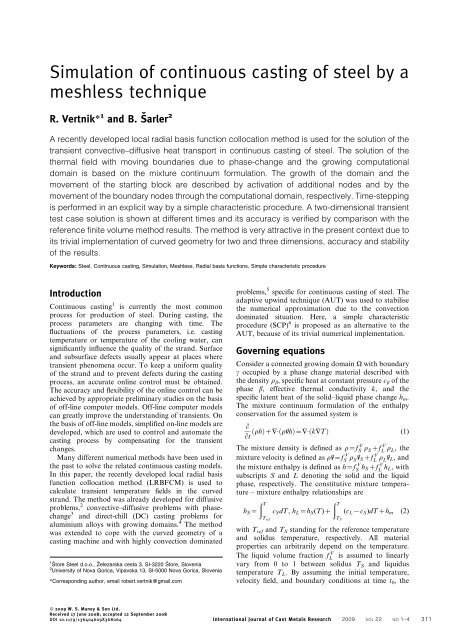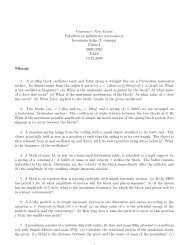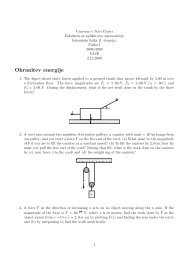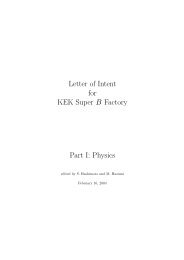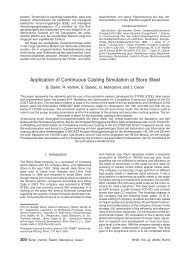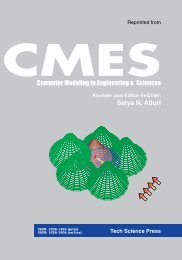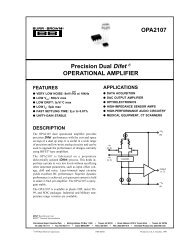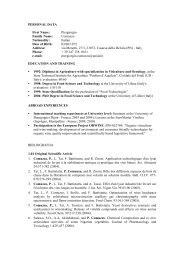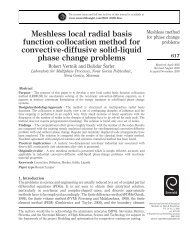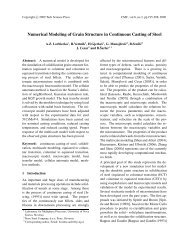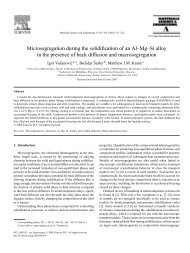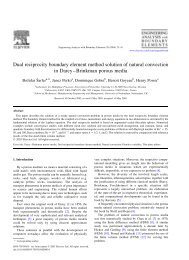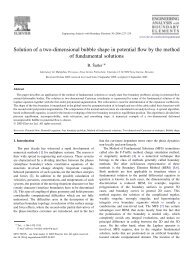Simulation of continuous casting of steel by a meshless technique
Simulation of continuous casting of steel by a meshless technique
Simulation of continuous casting of steel by a meshless technique
Create successful ePaper yourself
Turn your PDF publications into a flip-book with our unique Google optimized e-Paper software.
<strong>Simulation</strong> <strong>of</strong> <strong>continuous</strong> <strong>casting</strong> <strong>of</strong> <strong>steel</strong> <strong>by</strong> a<br />
<strong>meshless</strong> <strong>technique</strong><br />
R. Vertnik* 1 and B. Sˇarler 2<br />
A recently developed local radial basis function collocation method is used for the solution <strong>of</strong> the<br />
transient convective–diffusive heat transport in <strong>continuous</strong> <strong>casting</strong> <strong>of</strong> <strong>steel</strong>. The solution <strong>of</strong> the<br />
thermal field with moving boundaries due to phase-change and the growing computational<br />
domain is based on the mixture continuum formulation. The growth <strong>of</strong> the domain and the<br />
movement <strong>of</strong> the starting block are described <strong>by</strong> activation <strong>of</strong> additional nodes and <strong>by</strong> the<br />
movement <strong>of</strong> the boundary nodes through the computational domain, respectively. Time-stepping<br />
is performed in an explicit way <strong>by</strong> a simple characteristic procedure. A two-dimensional transient<br />
test case solution is shown at different times and its accuracy is verified <strong>by</strong> comparison with the<br />
reference finite volume method results. The method is very attractive in the present context due to<br />
its trivial implementation <strong>of</strong> curved geometry for two and three dimensions, accuracy and stability<br />
<strong>of</strong> the results.<br />
Keywords: Steel, Continuous <strong>casting</strong>, <strong>Simulation</strong>, Meshless, Radial basis functions, Simple characteristic procedure<br />
Introduction<br />
Continuous <strong>casting</strong> 1 is currently the most common<br />
process for production <strong>of</strong> <strong>steel</strong>. During <strong>casting</strong>, the<br />
process parameters are changing with time. The<br />
fluctuations <strong>of</strong> the process parameters, i.e. <strong>casting</strong><br />
temperature or temperature <strong>of</strong> the cooling water, can<br />
significantly influence the quality <strong>of</strong> the strand. Surface<br />
and subsurface defects usually appear at places where<br />
transient phenomena occur. To keep a uniform quality<br />
<strong>of</strong> the strand and to prevent defects during the <strong>casting</strong><br />
process, an accurate online control must be obtained.<br />
The accuracy and flexibility <strong>of</strong> the online control can be<br />
achieved <strong>by</strong> appropriate preliminary studies on the basis<br />
<strong>of</strong> <strong>of</strong>f-line computer models. Off-line computer models<br />
can greatly improve the understanding <strong>of</strong> transients. On<br />
the basis <strong>of</strong> <strong>of</strong>f-line models, simplified on-line models are<br />
developed, which are used to control and automate the<br />
<strong>casting</strong> process <strong>by</strong> compensating for the transient<br />
changes.<br />
Many different numerical methods have been used in<br />
the past to solve the related <strong>continuous</strong> <strong>casting</strong> models.<br />
In this paper, the recently developed local radial basis<br />
function collocation method (LRBFCM) is used to<br />
calculate transient temperature fields in the curved<br />
strand. The method was already developed for diffusive<br />
problems, 2 convective–diffusive problems with phasechange<br />
3 and direct-chill (DC) <strong>casting</strong> problems for<br />
aluminium alloys with growing domains. 4 The method<br />
was extended to cope with the curved geometry <strong>of</strong> a<br />
<strong>casting</strong> machine and with highly convection dominated<br />
1 Sˇ tore Steel d.o.o., Zˇ elezarska cesta 3, SI-3220 Sˇ tore, Slovenia<br />
2 University <strong>of</strong> Nova Gorica, Vipavska 13, SI-5000 Nova Gorica, Slovenia<br />
*Corresponding author, email robert.vertnik@gmail.com<br />
problems, 5 specific for <strong>continuous</strong> <strong>casting</strong> <strong>of</strong> <strong>steel</strong>. The<br />
adaptive upwind <strong>technique</strong> (AUT) was used to stabilise<br />
the numerical approximation due to the convection<br />
dominated situation. Here, a simple characteristic<br />
procedure (SCP) 6 is proposed as an alternative to the<br />
AUT, because <strong>of</strong> its trivial numerical implementation.<br />
Governing equations<br />
Consider a connected growing domain V with boundary<br />
c occupied <strong>by</strong> a phase change material described with<br />
the density r b, specific heat at constant pressure c b <strong>of</strong> the<br />
phase b, effective thermal conductivity k, and the<br />
specific latent heat <strong>of</strong> the solid–liquid phase change hm.<br />
The mixture continuum formulation <strong>of</strong> the enthalpy<br />
conservation for the assumed system is<br />
L<br />
Lt rh ð Þz+: ðr~vhÞ~+ : ðk+TÞ (1)<br />
The mixture density is defined as r~f V S rSzf V L rL, the<br />
mixture velocity is defined as r~v~f V S rS ~vSzf V L rL ~vL, and<br />
the mixture enthalpy is defined as h~f V S hSzf V L hL, with<br />
subscripts S and L denoting the solid and the liquid<br />
phase, respectively. The constitutive mixture temperature<br />
– mixture enthalpy relationships are<br />
hS~<br />
ð T<br />
Tref<br />
cSdT, hL~hS(T)z<br />
ð T<br />
TS<br />
(cL{cS)dTzhm (2)<br />
with Tref and TS standing for the reference temperature<br />
and solidus temperature, respectively. All material<br />
properties can arbitrarily depend on the temperature.<br />
The liquid volume fraction f V L is assumed to linearly<br />
vary from 0 to 1 between solidus TS and liquidus<br />
temperature TL. By assuming the initial temperature,<br />
velocity field, and boundary conditions at time t0, the<br />
ß 2009 W. S. Maney & Son Ltd.<br />
Received 17 June 2008; accepted 12 September 2008<br />
DOI 10.1179/136404609X368064 International Journal <strong>of</strong> Cast Metals Research 2009 VOL 22 NO 1–4 311
Vertnik and Sˇ arler <strong>Simulation</strong> <strong>of</strong> <strong>continuous</strong> <strong>casting</strong> <strong>of</strong> <strong>steel</strong> <strong>by</strong> a <strong>meshless</strong> <strong>technique</strong><br />
1 Geometry <strong>of</strong> billet caster with typical node arrangement and 5 point influence domain schematics<br />
mixture temperature at the time t 0zDt can be found,<br />
where t 0 is the starting time <strong>of</strong> the <strong>casting</strong> process and Dt<br />
is the time step.<br />
Solution procedure<br />
The governing equation is discretised in 2D real curved<br />
geometry (see Fig. 1) with Cartesian coordinates p x, p y<br />
with base vectors i x, i y <strong>by</strong> using the SCP in its explicit<br />
form. In this approach, the equation (1) is written in<br />
Lagrange formulation as:<br />
L(rh)<br />
(p(t),t)~+<br />
Lt<br />
: (k0+T0); p(t)<br />
~(px(t0)zDx) : ixz(py(t0)zDy) : iy (3)<br />
where Dx and Dy are the distances travelled in the x- and<br />
y-direction described as:<br />
Dx~-vxDt, Dy~-vyDt : (4)<br />
where -vx and -vy are average velocity values <strong>of</strong> v x and v y<br />
along the characteristic<br />
-vx~v0x 1{Dt Lv0x<br />
Lx , -vy~v0y 1{Dt Lv0y<br />
Ly , (5)<br />
where v0x and v0y are known velocity values at the initial<br />
time. The characteristic is a line that connects the<br />
material point at the beginning <strong>of</strong> the time step with the<br />
same material point at the end <strong>of</strong> the time step. In<br />
equation (3) the convective term disappears and<br />
diffusive and source terms are averaged quantities along<br />
the characteristic. The explicit time discretisation <strong>of</strong><br />
equation (3) along the characteristic is<br />
1<br />
r0 Dt h{h0 ðx{Dx,y{DyÞ ~+ : ðk0+T0Þ ðx{Dx,y{DyÞ (6)<br />
It is known that the solution <strong>of</strong> the above equation in<br />
moving coordinates leads to mesh updating and presents<br />
difficulties. An alternative way is to expand the terms<br />
into a Taylor expansion<br />
h0 (x{Dx,y{Dy)&h0{Dx Lh0<br />
Lx<br />
(x,y){Dy Lh0<br />
Ly (x,y), (7)<br />
312 International Journal <strong>of</strong> Cast Metals Research 2009 VOL 22 NO 1–4<br />
+ : ðk0+T0Þ (x{Dx,y{Dy)&+ : (k0+T0)h0<br />
{Dx L<br />
Lx +: ½ (k0+T0) Š (x,y){Dy L<br />
Ly +: ½ (k0+T0) Š (x,y) (8)<br />
In the LRBFCM the domain and the boundary are<br />
covered <strong>by</strong> overlapping influence domains. Each <strong>of</strong> the<br />
influence domains includes N neighboring nodes. The<br />
arbitrary function W is represented over a set <strong>of</strong> N nodes<br />
on each <strong>of</strong> the influence domains in the following way<br />
W(p)& XN<br />
n~1<br />
y n(p)an; y n(p)~ r 2 n (p)zc2 ;<br />
r 2 n (p)~(p{p n) : (p{p n), (9)<br />
where yn stands for the shape functions, an for the<br />
coefficients <strong>of</strong> the shape functions, r n for the radial<br />
distance between two collocation points in a subdomain,<br />
and c for the shape parameter, respectively. The<br />
coefficients an are calculated <strong>by</strong> collocation with the<br />
multiquadric radial basis function 7,8 as the shape<br />
function.<br />
The growth <strong>of</strong> the domain is performed <strong>by</strong> moving the<br />
bottom boundary nodes according to the <strong>casting</strong><br />
velocity and time step length in <strong>casting</strong> direction<br />
Dc l5v 0l?Dt. The unknown values <strong>of</strong> the moving boundary<br />
nodes G(t 0zDt) are set from equation (9). When the<br />
distance between the moving boundary nodes and the<br />
fixed domain nodes exceeds two times the typical grid<br />
distance <strong>of</strong> the node arrangement, new inner nodes are<br />
inserted between the moving boundary nodes and<br />
the fixed inner nodes. Their values are obtained <strong>by</strong><br />
equation (9).<br />
Numerical examples<br />
The transient simulation <strong>of</strong> the Sˇtore–Steel billet caster 9<br />
with the simplified boundary conditions and material<br />
properties presented. The boundary conditions are:<br />
(i) the inner and outer surface – Robin boundary<br />
condition with the following heat transfer<br />
coefficients: mould 2000 W m 22 K 21 , radiation<br />
and sprays 600 W m 22 K 21 , and rolls
2 Calculated temperature on centreline (upper curves)<br />
and at outer side (lower curves). t5340 s<br />
1200 W m 22 K 21 , with the reference temperature<br />
set to 293?15 K<br />
(ii) the top surface – Dirichlet boundary condition<br />
with the temperature 1763?5 K and<br />
(iii) the bottom surface – Neumann boundary condition<br />
with zero heat flux<br />
with the following simplified material properties:<br />
r S~r L~7800 kg m {3 , kS~35 W m {1 K {1 ,<br />
kL~52 W m {1 K {1 , cS~700 J kg 1 K {1 ,<br />
cL~800 J kg 1 K {1 and hm~227 kJ kg {1<br />
The results are compared with the results obtained from<br />
the fluid dynamics s<strong>of</strong>tware Fluent, which is based on<br />
the finite volume method (FVM). In Fluent, the growth<br />
<strong>of</strong> the domain was realised <strong>by</strong> the dynamic mesh mode.<br />
Figure 1 represents the geometry <strong>of</strong> the caster with the<br />
node arrangement during the simulation. Due to the<br />
high temperature gradients at the boundary, the node<br />
arrangement is denser near the boundary.<br />
Figure 2 shows the calculated temperature along the<br />
billet on the outer side and the centreline obtained with<br />
the LRBFCM and the FVM.<br />
Conclusions<br />
This paper represents a solution <strong>of</strong> the transient<br />
temperature field in the two-dimensional curved geometry<br />
<strong>of</strong> the <strong>steel</strong> billet caster <strong>by</strong> a <strong>meshless</strong> <strong>technique</strong>.<br />
The governing equation is solved in its strong form on a<br />
moving domain, where both the material and the<br />
inter-phase boundary are simultaneously moving. The<br />
growing <strong>of</strong> the computational domain is performed <strong>by</strong><br />
moving the bottom boundary nodes and <strong>by</strong> inserting<br />
Vertnik and Sˇ arler <strong>Simulation</strong> <strong>of</strong> <strong>continuous</strong> <strong>casting</strong> <strong>of</strong> <strong>steel</strong> <strong>by</strong> a <strong>meshless</strong> <strong>technique</strong><br />
new inner nodes. A minimal discretisation man-effort<br />
was put into the transition <strong>of</strong> the discretisation from the<br />
flat to the real curved geometry. The extension <strong>of</strong> the<br />
method to cope with higher dimensions is straightforward.<br />
The stability problem <strong>of</strong> the dominated convection<br />
is for the first time solved in the LRBFCM context<br />
<strong>by</strong> using the explicit SCP. The accuracy <strong>of</strong> the new<br />
method is tested <strong>by</strong> comparison <strong>of</strong> the results with the<br />
Fluent s<strong>of</strong>tware package. A very good agreement<br />
between both methods is observed. The method was<br />
chosen as the core in the simulation system <strong>of</strong> the Sˇtore<br />
Steel billet caster. 9,10 Our ongoing research is focused on<br />
the extension <strong>of</strong> the method to calculate the turbulent<br />
fluid flow <strong>of</strong> the <strong>continuous</strong> <strong>casting</strong> processes and<br />
to couple the macroscopic with the microscopic<br />
simulations.<br />
Acknowledgements<br />
The first author would like to acknowledge the Public<br />
Agency for Technology <strong>of</strong> the Republic <strong>of</strong> Slovenia for<br />
support in the framework <strong>of</strong> the PhD programme. The<br />
second author would like to thank the Slovenian<br />
Research Agency for support in the framework <strong>of</strong> the<br />
project L2–7204 Modelling and Optimisation <strong>of</strong><br />
Continuous Casting, which was part-financed <strong>by</strong> the<br />
European Union, European Social Fund.<br />
References<br />
1. W.R. Irwing: ‘Continuous Casting <strong>of</strong> Steel’, 1993, London, The<br />
Institute <strong>of</strong> Materials.<br />
2. B. Sˇarler and R. Vertnik: Comp, Math.Applic., 2006, 51, 1269–<br />
1282.<br />
3. R. Vertnik and B. Sˇarler: Int.J.Numer.Methods Heat Fluid Flow,<br />
2006, 16, 617–640.<br />
4. R. Vertnik, M. Zalozˇnik and B. Sˇarler: Eng.Anal., 2006, 30, 847–<br />
855.<br />
5. R. Vertnik, B. Sˇarler, Z. Bulinski and G. Manojlović: Proc. 2nd<br />
Int. Conf. <strong>of</strong> ‘<strong>Simulation</strong> and Modelling <strong>of</strong> Metallurgical<br />
Processes in Steelmaking’, Graz, Austria, September 2007,<br />
ASMET.<br />
6. O.C. Zienkiewicz and R.L. Taylor: ‘The Finite Element Method,<br />
Fitfh edition, Volume 3: Fluid dynamics’, 2000, London,<br />
Butterworth–Heinemann.<br />
7. G.R. Liu: ‘Mesh Free Methods’, 2003, Boca Raton, CRC Press.<br />
8. M.D. Buhmann: ‘Radial Basis Function’, 2003, Cambridge,<br />
Cambridge University Press.<br />
9. B. Sˇarler, R. Vertnik, H. Gjerkesˇ, A. Lorbiecka, G. Manojlović, J.<br />
Cesar, B. Marčič and M. Sabolič Mijovič: WSEAS transactions on<br />
systems and control, 2006, 2, 294–299.<br />
10. B. Sˇarler, R. Vertnik, S. Sˇaletić, G. Manojlović and J. Cesar: Bergund<br />
Hüttenmännische Monatshefte, 2005, 9, 300–306.<br />
11. A. Fic, A.J. Nowak and R. Białecki: Eng.Anal. Boundary Elements,<br />
2000, 24, 215–223.<br />
12. B. Sˇarler, R. Vertnik and J. Perko: Comp.Mat.Cont., 2005, 2, 77–<br />
83.<br />
13. Y.T. Gu and G.R. Liu: Comp.Mech., 2006, 38, 171–182.<br />
International Journal <strong>of</strong> Cast Metals Research 2009 VOL 22 NO 1–4 313


